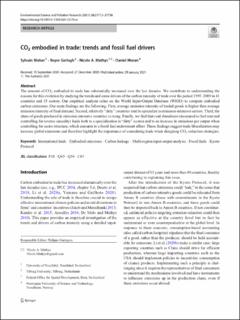| dc.contributor.author | Weber, Sylvain | |
| dc.contributor.author | Gerlagh, Reyer | |
| dc.contributor.author | Mathys, Nicole | |
| dc.contributor.author | Moran, Daniel | |
| dc.date.accessioned | 2022-03-21T12:50:22Z | |
| dc.date.available | 2022-03-21T12:50:22Z | |
| dc.date.created | 2021-09-30T20:25:03Z | |
| dc.date.issued | 2021 | |
| dc.identifier.citation | Environmental science and pollution research international. 2021, 28 27712-27730. | en_US |
| dc.identifier.issn | 0944-1344 | |
| dc.identifier.uri | https://hdl.handle.net/11250/2986496 | |
| dc.description.abstract | The amount of CO2 embodied in trade has substantially increased over the last decades. We contribute to understanding the reasons for this evolution by studying the trends and some drivers of the carbon intensity of trade over the period 1995–2009 in 41 countries and 35 sectors. Our empirical analysis relies on the World Input-Output Database (WIOD) to compute embodied carbon emissions. Our main findings are the following. First, average emission intensity of traded goods is higher than average emission intensity of final demand. Second, relatively “dirty” countries tend to specialize in emission-intensive sectors. Third, the share of goods produced in emission-intensive countries is rising. Finally, we find that coal abundance (measured as fuel rent and controlling for reverse causality) leads both to a specialization in “dirty” sectors and to an increase in emissions per output when controlling for sector structure, which amounts to a fossil fuel endowment effect. These findings suggest trade liberalization may increase global emissions and therefore highlight the importance of considering trade when designing CO2 reduction strategies. | en_US |
| dc.language.iso | eng | en_US |
| dc.publisher | Springer | en_US |
| dc.rights | Navngivelse 4.0 Internasjonal | * |
| dc.rights.uri | http://creativecommons.org/licenses/by/4.0/deed.no | * |
| dc.title | CO2 embodied in trade: Trends and fossil fuel drivers | en_US |
| dc.type | Peer reviewed | en_US |
| dc.type | Journal article | en_US |
| dc.description.version | publishedVersion | en_US |
| dc.source.pagenumber | 27712-27730 | en_US |
| dc.source.volume | 28 | en_US |
| dc.source.journal | Environmental science and pollution research international | en_US |
| dc.identifier.doi | 10.1007/s11356-020-12178-w | |
| dc.identifier.cristin | 1941706 | |
| dc.relation.project | Norges forskningsråd: 287690 | en_US |
| cristin.ispublished | true | |
| cristin.fulltext | original | |
| cristin.qualitycode | 1 | |

